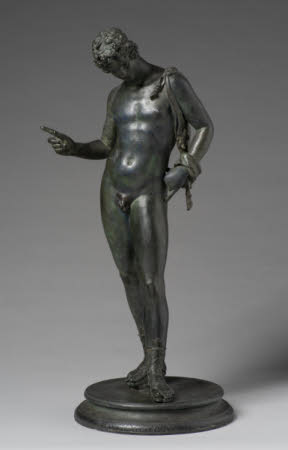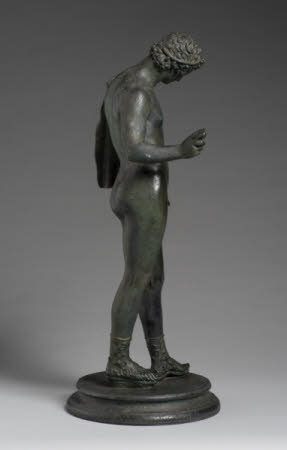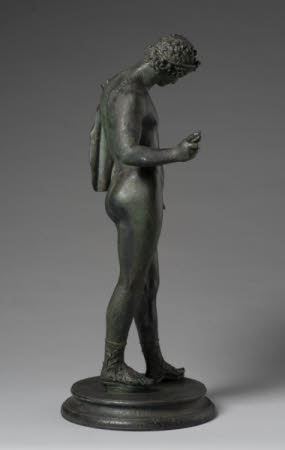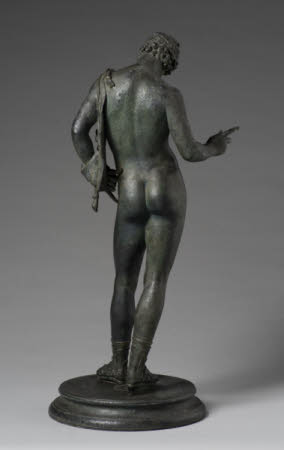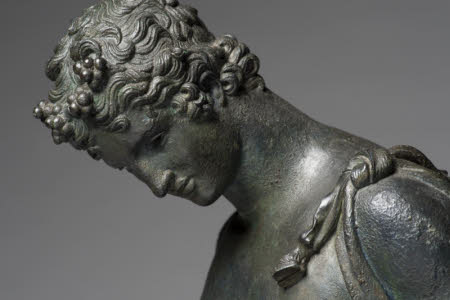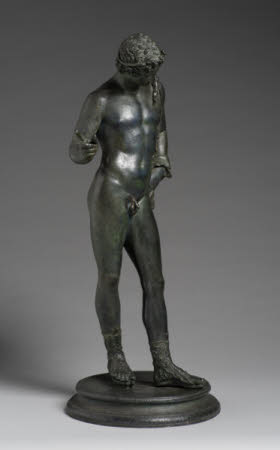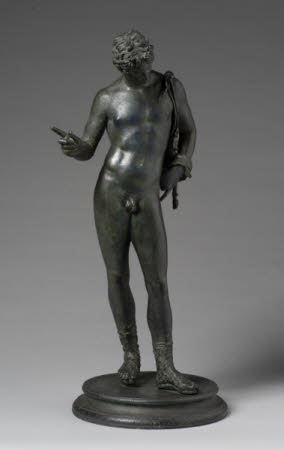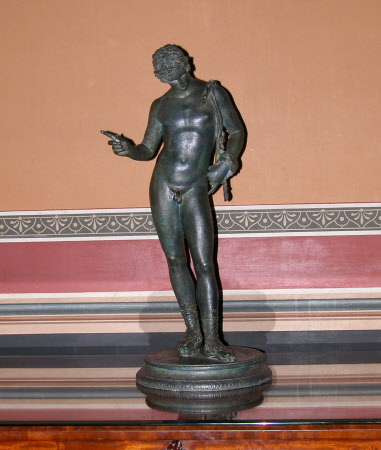Statuette of Bacchus, traditionally Narcissus
Sabatino de Angelis (b.1838)
Category
Art / Sculpture
Date
c. 1800 - 1900
Materials
Bronze
Measurements
615 x 300 mm; 233 mm (Diameter)
Place of origin
Naples
Order this imageCollection
Ickworth, Suffolk
NT 850842
Summary
Sculpture, bronze; statuette of Bacchus; Naples, Sabatino de Angelis foundry, after an antique bronze figure; c. 1880-1900. A small reproduction of a bronze figure of Bacchus (Dionysus), the Roman god of wine, discovered in Pompeii in 1862, and today in the Museo Nazionale Archaeologico in Naples. The statuette, which was long thought to be a figure of the youth Narcissus, who was said to have fallen in love with his own reflection, is now recognized to be an image of Bacchus, the Roman god of wine. The figure became immensely popular in the later nineteenth century, with casts being made in various Neapolitan foundries, of which the manufactory run by Sabatino de Angelis (1838 – c. 1915) was one of the most important.
Full description
Bronze figure of a youth, traditionally identified as Narcissus but probably a representation of Dionysus (Roman: Bacchus), the god of wine. He stands in slight contrapposto, with his torso twisted, his left leg forward, left hand on hip and right hand raised in admonition, head slightly bent as he looks downwards and to his left. He is naked except for an animal skin tossed over his left shoulder, whilst on his feet he wears elaborate sandals. The bronze has been given a deliberately aged patina, whilst the eyes have been silvered. On a separately case base, around the edges of which run friezes of beading and palmette decoration. Signed and dated on the base. The so-called Narcissus was one of the most popular of the finds from Pompei and Herculaneum that continued to emerge from excavations in the course of the nineteenth century. The small statuette of an elegant naked youth was discovered in Pompeii in 1862, in the house now known as the Casa di Narcisso or the House of the Statue of Narcissus. Today, the bronze statuette is in the Museo Archeologico Nazionale in Naples (Inv. 5003). The figure was long thought to represent Narcissus, the handsome youth who fell in love with his own reflection in a pool, pining away as he gazed at himself. However, the ivy leaves in the hair and the animal skin draped over the shoulder would suggest it is in fact a representation of Bacchus (Greek Dionysus), god of wine. The Narcissus was the last antique statue discovered in Italy to enjoy great fame and also to have been extensively copied (Haskell and Penny 1981, pp. 271-72, no. 64, fig. 141; Haskell and Penny 2024, I, pp. 432-33, no. 64). The little bronze would become extraordinarily popular, being described as the ‘pearl’ of the National Museum’s collections (Domenico Monaco, A Complete Handbook to the National Museum in Naples, 3rd edition, London 1883, p. 68). Towards the end of the century, Louis Conforti went even further, describing it as ‘the most splendid antique master-piece extant [….] It surpasses in beauty all the other sculptures that come from Pompeii…’ (Louis Conforti, The National Museum of Naples, Naples c. 1899, p. 10). It is hardly surprising therefore that the great popularity of the Narcissus should have led it to become a standard product for the Neapolitan foundries specialising in reproductions from Pompei and Herculaneum, including De Angelis, the Fonderie Artistiche Riunite and largest of all, the Chiurazzi foundry. In the 1900 catalogue for the De Angelis foundry, the original bronze statue was described as ‘a marvel of art and of sculpture‘ (‘merveille d’art et de plastique’). Casts were offered for sale at the original size (62 cms.) and at the reduced size of 38 cms., and with three choices of patination, the greenish ‘Pompeii’, the very dark ‘Herculaneum’ and the light brown ‘Moderne’. In the 1910 catalogue for the united Chiurazzi and De Angelis foundries, the Narcissus was offered in two additional even smaller sizes, 27 and 11 cms., and in the three patinations. The smallest 11 cm. high statuette was also offered in a silvered version, for the high price of 250 francs. In the 1929 catalogue the figure was again singled out for praise, being called ‘of extraordinary beauty’. (Chiurazzi. Fonderie, Ceramica, Marmeria, Naples 1929, p. 61, no. 91). The Ickworth bronze is the size of the original statuette and its patina would seem to be the slightly greenish ‘Pompeii’. It must have been acquired in order to furnish the Pompeian Room in the West Corridor at Ickworth, completed in 1879. The De Angelis foundry was established in Naples in 1840 by the father of Sabatino de Angelis (1838 – c. 1915), under whose direction it became, along with the Chiurazzi and Giorgio Sommer, one of the most successful and best-known of the Neapolitan foundries, capitalizing on the huge international demand in the later nineteenth century for high-quality copies of antiquities from Herculaneum, Pompeii, Rome and elsewhere, after the Italian government had, in 1860, agreed to allow the making of copies of objects in the museum in Naples. All three foundries published catalogues of the products they offered, the 1900 catalogue from Sabatino de Angelis proudly proclaiming on its cover that the firm supplied casts to various European royal houses, as well as leading museums in London, Edinburgh, Glasgow, Boston, Chicago, New York and elsewhere. In the 1870s, Sabatino de Angelis also entered into a joint venture with the rival Chiurazzi foundry, forming the Fonderie Artistiche Riunite, the main purpose of which was to cater for the burgeoning American market. It also published a catalogue in 1910, largely based on the 1900 de Angelis catalogue, suggesting that it was this foundry that had provided the majority of the models for the joint venture. It certainly appears to be the case that de Angelis was especially highly regarded internationally, the American curator Edward Robinson writing in 1892 that Sabatino de Angelis was ‘by far the best of the numerous Neapolitan copyists, his talent and feeling for his line of work being rare in any generation.’ (Edward Robinson, ‘Casts for the Metropolitan Museum of New York’, American Architect and Building News, 37 no. 872, 10 September 1892, pp. 166-68, p. 167). Testament to the popularity of the figure are the several other casts in National Trust collections. An example of a Chiurazzi cast of the Narcissus is at Sizergh castle (NT 998583), whilst two others made in the foundry run by the German-born photographer Giorgio Sommer are at Anglesey Abbey (NT 515072) and Grey’s Court (NT 195758). Sommer’s casts are of particular interest, since the original model was made for Sommer by the gifted but wayward Neapolitan sculptor Vincenzo Gemito (1852-1929). Jeremy Warren June 2025
Provenance
Part of the Bristol Collection. Acquired by the National Trust in 1956 under the auspices of the National Land Fund, later the National Heritage Memorial Fund.
Marks and inscriptions
On base, cast-in signature:: Sabatino & fils / Naples 1900
Makers and roles
Sabatino de Angelis (b.1838) , sculptor De Angelis and Son (Naples 1840 - 1915), founder
References
Sabatino 1900: Catalogue illustré de Sab. De Angelis et fils, Naples, Naples 1900, p. 43. Chiurazzi and De Angelis 1910: Fonderie Artistiche Riunite. J. Chiurazzi & Fils – S. De Angelis & Fils. Bronzes, Marbres, Argenterie, Naples 1910, p. 211. Haskell and Penny 1981: Francis Haskell and Nicholas Penny, Taste and the Antique, The Lure of Classical Sculpture 1500 - 1900, New Haven and London, 1981, pp. 271-72, no. 64, fig. 141. Haskell and Penny 2024: Francis Haskell and Nicholas Penny, revised and amplified bv Adriano Aymonimo and Eloisa Dodero, Taste and the Antique. The Lure of Classical Sculpture 1500-1900, 3 vols., Turnhout 2024, I, pp. 432-33, no. 64, esp. note 13.
